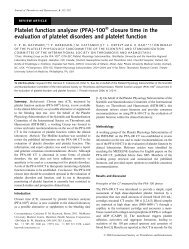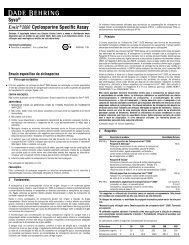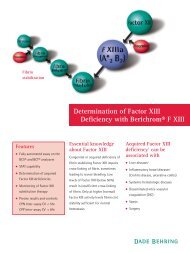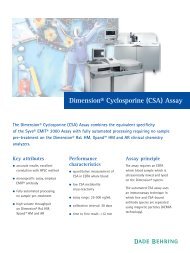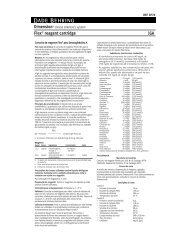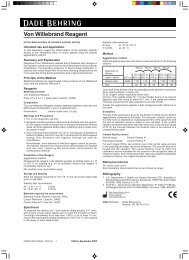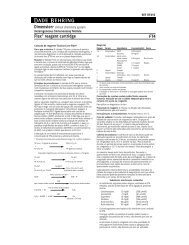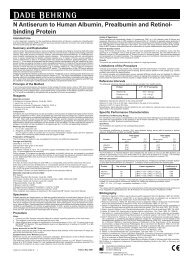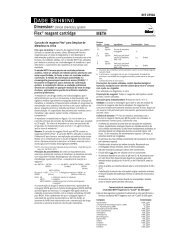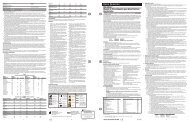Tempo de Trombina - Medcorp
Tempo de Trombina - Medcorp
Tempo de Trombina - Medcorp
You also want an ePaper? Increase the reach of your titles
YUMPU automatically turns print PDFs into web optimized ePapers that Google loves.
BC Thrombin Reagent<br />
Inten<strong>de</strong>d Use<br />
Reagent for the quantitative <strong>de</strong>termination of the thrombin time in citrated human plasma.<br />
Summary and Explanation<br />
The <strong>de</strong>termination of the thrombin time using BC Thrombin Reagent is suitable:<br />
1. for monitoring fibrinolysis therapy 1,2 ,<br />
2. for screening for disor<strong>de</strong>rs of fibrin formation and in cases of suspected severe<br />
fibrinogen <strong>de</strong>ficiency states 1,2 ,<br />
3. for differentiating between a heparin-induced prolongation of the thrombin time<br />
and fibrin formation disor<strong>de</strong>rs 1,2 .<br />
Prolonged thrombin times are measured both in patients with disor<strong>de</strong>rs of fibrin polymerization<br />
as well as during heparin treatment. Differentiation between these patient types<br />
can be achieved using Batroxobin Reagent (Da<strong>de</strong> Behring Marburg GmbH, Co<strong>de</strong> No.<br />
OUOV).<br />
Principle of the Method<br />
Thrombin converts the fibrinogen in the plasma sample into fibrin, thus producing a<br />
fibrin clot. The time taken for the fibrin clot to form is measured.<br />
Reagents<br />
Materials provi<strong>de</strong>d<br />
BC Thrombin Reagent, Testkit, Co<strong>de</strong> No. OWNA with<br />
10 x for 5 mL BC Thrombin Reagent<br />
1 x 50 mL Buffer Solution<br />
Composition<br />
BC Thrombin Reagent lyophilized: bovine thrombin, bovine albumin<br />
Buffer Solution for BC Thrombin Reagent: HEPES (25 mmol/l), pH 7.4<br />
Preservatives: 5-chloro-2-methyl-isothiazole-3-one (6 mg/l) and<br />
2-methyl-isothiazole-3-one (2 mg/l)<br />
Warnings and Precautions<br />
For in vitro diagnostic use.<br />
Preparation of the Reagent<br />
Reconstitute the contents of a vial of BC Thrombin Reagent in the labelled quantity of<br />
buffer solution. After reconstitution, as well as for every further use, the reagent solution<br />
must be warmed to +37 °C and maintained at this temperature for 15 minutes<br />
(not necessary if the BCS ® is used).<br />
Mix carefully once more before using.<br />
Storage and Stability<br />
Stored unopened at +2 to +8 °C, the BC Thrombin Reagent can be used up to the<br />
expiration date given on the label.<br />
Stability after reconstitution:<br />
at + 37 °C 8 hours<br />
at + 15 °C 48 hours<br />
at + 2 to +8 °C 7 days<br />
at -20 °C 1 month<br />
The reconstituted reagent can be frozen once in the original vial. The buffer solution is<br />
stable for 12 weeks at +2 to +25 °C once opened.<br />
Different coagulation analyzers have individual stability data.<br />
Instruments<br />
BC Thrombin Reagent can be used in a great number of coagulation analyzers.<br />
Observe the operating instructions issued by the analyzer’s manufacturer!<br />
Materials required but not provi<strong>de</strong>d<br />
Control Plasma N, Co<strong>de</strong> No. ORKE<br />
Da<strong>de</strong> ® Ci-Trol ® Level 1, Bestell-Nr. 291070*<br />
Coagulation analyzer (see Chapter titled ”Limitations of the Procedure”)<br />
Pipettes<br />
Plastic test tubes<br />
Distilled water<br />
* not available in the US<br />
Specimens<br />
To obtain the plasma, carefully mix 1 part sodium citrate solution (0.11 mol/l) with 9<br />
parts venous blood, avoiding the formation of foam. Centrifuge immediately at no less<br />
than 1,500 x g for at least 10 minutes. Remove supernatant plasma and store at +15<br />
to +25 °C until the test.<br />
Stability of the sample at +15 to +25 °C: 4 hours.<br />
Measure heparin-containing plasma samples within 2 hours.<br />
In the US please refer to the NCCLS Document H21-A2, entitled "Collection, Transport<br />
and Processing of Blood Specimens for Coagulation Testing and Performance of Coagulation<br />
Assays".<br />
Do not freeze the samples!<br />
Procedure<br />
Manual:<br />
Pipette into a test tube prewarmed to +37 °C:<br />
Citrated plasma 100 µL<br />
BC Thrombin Reagent (+37 °C) 250 µL<br />
On adding the reagent, <strong>de</strong>termine the coagulation time (e.g. time for the initial<br />
absorbance to increase by 0.06)<br />
Automatic:<br />
Special instructions for coagulation analyzers may be obtained from Da<strong>de</strong> Behring by<br />
request.<br />
Internal Quality Control<br />
Normal range: Control Plasma N<br />
Da<strong>de</strong> ® Ci-Trol ® Level 1<br />
Pathological range: Use a normal plasma adjusted to an appropriate concentration<br />
(e.g., 0.2 IU/mL) with the same form of heparin that is to<br />
be assayed in the sample to be tested. Multiple <strong>de</strong>terminations<br />
should be run to establish a confi<strong>de</strong>nce interval.<br />
A control should be measured at least every 8 hours on each testing day. Test<br />
control plasma in the same manner as patient samples.<br />
For a normal range control, the analytical value obtained must be within the assigned<br />
range given for the control in the lot-<strong>de</strong>pen<strong>de</strong>nt table of values.<br />
For a pathological range control, the value obtained should be within the confi<strong>de</strong>nce<br />
interval established by the laboratory.<br />
If the measured control value lies outsi<strong>de</strong> the confi<strong>de</strong>nce level previously established,<br />
then the coagulation analyzer and the reagents should be examined.<br />
Results<br />
The results are given in seconds.<br />
Limitations of the Procedure<br />
There are appropriate coagulation analyzers for which Da<strong>de</strong> Behring provi<strong>de</strong>s operating<br />
instructions. The utilization of BC Thrombin Reagent in other coagulation analyzers<br />
must be validated by the testing laboratory. In doing so, performance data other<br />
than that provi<strong>de</strong>d may be obtained.<br />
Carry-over of traces of thrombin may interfere with subsequent coagulation analyses.<br />
Therefore only single-use plastic materials should be used.<br />
Expected Values<br />
In a study of 39 citrated plasma samples from healthy adults using BC Thrombin Reagent<br />
on the BCT**, the calculated 95th percentile was <strong>de</strong>termined to be < 21 seconds.<br />
Systematic <strong>de</strong>viations from this range may be due to the instrument used. If necessary,<br />
the laboratory may have to establish its own reference interval.<br />
Specific Performance Characteristics<br />
Precision<br />
Over a five day period, precision studies (one run per day in replicates of eight) were<br />
performed by assaying normal and pathological control plasmas. For normal control plasmas<br />
(n = 40), the within-run precision ranged from 2.2 to 2.6%, while the total precision<br />
ranged from 3.8 to 4.7%. For a pathological control plasma (n = 24), the within-run precision<br />
was 6.2%, while the total precision was 7.4%.<br />
Method Comparison<br />
A method comparison study was performed with the BC Thrombin Reagent and<br />
another commercially available assay. A total of 67 patient plasma samples (20 from<br />
normal blood donors, 27 from patients un<strong>de</strong>rgoing heparin therapy, and 20 from patients<br />
with increased fibrin <strong>de</strong>gradation products) were tested by both methods. Regression<br />
analysis <strong>de</strong>termined a correlation coefficient of 0.93, a y-intercept of -5.55<br />
seconds and a slope of 1.48.<br />
Bibliography<br />
1. Sirridge, M.S. Laboratory evaluation of hemostasis. 2nd Ed. Phila<strong>de</strong>lphia: Lea &<br />
Febiger; 1974: 148<br />
2. Biggs, R. Human blood coagulation, haemostasis and thrombosis. 2nd Ed. Oxford:<br />
Blackwell Scientific Publications; 1976: 722<br />
Da<strong>de</strong> and Ci-Trol are registered tra<strong>de</strong>marks of Da<strong>de</strong> Behring, Inc. in the USA, Germany<br />
and other countries.<br />
BCS is a registered tra<strong>de</strong>mark of Da<strong>de</strong> Behring Marburg GmbH in the USA, in Germany<br />
and other countries.<br />
** BCT is a registered tra<strong>de</strong>mark of Da<strong>de</strong> Behring Marburg GmbH in Germany and<br />
other countries.<br />
Da<strong>de</strong> Behring Marburg GmbH<br />
Emil-von-Behring-Str. 76<br />
D-35041 Marburg<br />
www.da<strong>de</strong>behring.com<br />
USA Distributor:<br />
Da<strong>de</strong> Behring Inc.<br />
Newark, DE 19714 U.S.A.<br />
OWNA G11 E0540 (1111) H 1 Edition September 2003
BC-Thrombin-Reagenz<br />
Anwendungsbereich<br />
Reagenz zur quantitativen Bestimmung <strong>de</strong>r Thrombinzeit in humanem Citratplasma.<br />
Diagnostische Be<strong>de</strong>utung<br />
Die Bestimmung <strong>de</strong>r Thrombinzeit mit BC-Thrombin-Reagenz ist geeignet:<br />
1. zur Überwachung <strong>de</strong>r Fibrinolyse-Therapie 1,2 ,<br />
2. als Suchtest auf Störungen <strong>de</strong>r Fibrinbildung bzw. bei Verdacht auf schwere Fibrinogenmangelzustän<strong>de</strong><br />
1,2 ,<br />
3. zur Unterscheidung zwischen einer heparinbedingten Verlängerung <strong>de</strong>r Thrombinzeit<br />
und Fibrinbildungsstörungen 1,2 .<br />
Sowohl bei Störungen <strong>de</strong>r Fibrinpolymerisation als auch bei Vorliegen von Heparin<br />
wird eine verlängerte Thrombinzeit gemessen. Eine Differenzierung kann mit Hilfe<br />
<strong>de</strong>s Batroxobin-Reagenzes (Da<strong>de</strong> Behring Marburg GmbH, Bestell-Nr. OUOV) erfolgen.<br />
Prinzip <strong>de</strong>r Metho<strong>de</strong><br />
Thrombin wan<strong>de</strong>lt das in <strong>de</strong>r Plasmaprobe enthaltene Fibrinogen in Fibrin um,<br />
wodurch ein Gerinnsel entsteht. Es wird die Zeit bis zur Gerinnselbildung gemessen.<br />
Reagenzien<br />
Inhalt <strong>de</strong>r Han<strong>de</strong>lspackung<br />
BC-Thrombin-Reagenz, Testkit, Bestell-Nr. OWNA mit<br />
10 x für 5 ml BC-Thrombin-Reagenz<br />
1 x 50 ml Pufferlösung<br />
Zusammensetzung<br />
BC-Thrombin-Reagenz lyophilisiert: Thrombin vom Rind, Albumin vom Rind<br />
Pufferlösung für BC-Thrombin-Reagenz: HEPES (25 mmol/l), pH 7,4<br />
Konservierungsmittel: 5-Chlor-2-methyl-isothiazol-3-on (6 mg/l) und<br />
2-Methyl-isothiazol-3-on (2 mg/l)<br />
Warnungen und Vorsichtsmaßnahmen<br />
Nur zur in vitro diagnostischen Anwendung.<br />
Vorbereitung <strong>de</strong>r Reagenzien<br />
Inhalt einer Abfüllung BC-Thrombin-Reagenz mit <strong>de</strong>r auf <strong>de</strong>m Etikett angegebenen<br />
Menge Pufferlösung einlösen. Nach <strong>de</strong>m Einlösen und vor je<strong>de</strong>m weiteren Gebrauch<br />
ist die Reagenzlösung auf +37 °C zu erwärmen und 15 min lang bei dieser Temperatur<br />
zu halten (kann bei Verwendung am BCS ® entfallen). Vor Gebrauch noch einmal<br />
vorsichtig mischen.<br />
Haltbarkeit und Lagerungsbedingungen<br />
BC-Thrombin-Reagenz ist, ungeöffnet bei +2 bis +8 °C gelagert, bis zu <strong>de</strong>m auf <strong>de</strong>m<br />
Etikett angegebenen Datum verwendbar.<br />
Stabilität nach Rekonstitution:<br />
bei +37 °C 8 Stun<strong>de</strong>n<br />
bei +15 °C 48 Stun<strong>de</strong>n<br />
bei +2 bis +8 °C 7 Tage<br />
bei -20 °C 1 Monat<br />
Das gelöste Reagenz kann einmal in <strong>de</strong>r Originalflasche eingefroren wer<strong>de</strong>n.<br />
Die Stabilität <strong>de</strong>r Pufferlösung nach <strong>de</strong>m erstmaligen Öffnen beträgt bei +2 bis +25 °C<br />
12 Wochen.<br />
Die verschie<strong>de</strong>nen Gerinnungsmeßgeräte haben individuelle Stabilitätsdaten.<br />
Geräte<br />
BC-Thrombin-Reagenz kann mit einer Vielzahl von Gerinnungsmeßgeräten verwen<strong>de</strong>t<br />
wer<strong>de</strong>n.<br />
Bedienungsanleitung <strong>de</strong>s Geräteherstellers beachten!<br />
Zusätzlich benötigte Materialien<br />
Kontroll-Plasma N, Bestell-Nr. ORKE<br />
Da<strong>de</strong> ® Ci-Trol ® Level 1, Bestell-Nr. 291070*<br />
Gerinnungsmeßgerät (siehe Kapitel "Einschränkungen <strong>de</strong>r Testdurchführung")<br />
Pipetten<br />
Plastikröhrchen<br />
<strong>de</strong>stilliertes Wasser<br />
* nicht in <strong>de</strong>n USA erhältlich<br />
Untersuchungsmaterial<br />
Zur Plasmagewinnung 1 Teil Natriumcitrat-Lösung (0,11 mol/l) mit 9 Teilen Venenblut<br />
sorgfältig unter Vermeidung von Schaumbildung mischen. Sofort min<strong>de</strong>stens 10 min<br />
bei min<strong>de</strong>stens 1.500 x g zentrifugieren, überstehen<strong>de</strong>s Plasma abhebern und bis<br />
zum Test bei +15 bis +25 °C aufbewahren.<br />
Stabilität <strong>de</strong>r Probe bei +15 bis +25 °C: 4 Stun<strong>de</strong>n.<br />
Heparinhaltige Plasmen innerhalb von 2 Stun<strong>de</strong>n messen.<br />
In <strong>de</strong>n USA bitte auf das NCCLS Dokument H21-A2 mit <strong>de</strong>m Titel "Collection, Transport<br />
and Processing of Blood Specimens for Coagulation Testing and Performance of Coagulation<br />
Assays" beziehen.<br />
Proben nicht einfrieren!<br />
Testdurchführung<br />
Manuell:<br />
In ein auf +37 °C vorgewärmtes Teströhrchen pipettieren:<br />
Citratplasma 100 µl<br />
BC-Thrombin-Reagenz (+37 °C) 250 µl<br />
Mit Zugabe <strong>de</strong>s Reagenzes Gerinnungszeit (z. B. Zeit für die Zunahme <strong>de</strong>r<br />
Anfangsextinktion um 0,06) bestimmen<br />
Automatisch:<br />
Spezielle Vorschriften für Gerinnungsmeßgeräte sind von Da<strong>de</strong> Behring auf Anfrage<br />
erhältlich.<br />
Interne Qualitätskontrolle<br />
Normalbereich: Kontroll-Plasma N<br />
Da<strong>de</strong> ® Ci-Trol ® Level 1<br />
Pathologischer Bereich: Es ist ein Normalplasma, das mit einer geeigneten Konzentration<br />
(z.B. 0,2 IU/ml) <strong>de</strong>s zu messen<strong>de</strong>n Heparins<br />
aufgestockt wur<strong>de</strong>, einzusetzen. Zur Festlegung eines<br />
Vertrauensbereichs sind mehrere Bestimmungen durchzuführen.<br />
Min<strong>de</strong>stens alle 8 Stun<strong>de</strong>n an je<strong>de</strong>m Testtag sollten Kontrollen gemessen wer<strong>de</strong>n.<br />
Kontroll-Plasmen sind wie Patientenproben einzusetzen.<br />
Der Meßwert für die Normalkontrolle muß im Sollbereich liegen, <strong>de</strong>r in <strong>de</strong>r chargenabhängigen<br />
Wertetabelle <strong>de</strong>r Kontrolle angegeben ist.<br />
Der Wert für die pathologische Kontrolle sollte innerhalb <strong>de</strong>s im Labor ermittelten<br />
Vertrauensbereiches liegen.<br />
Liegt <strong>de</strong>r gemessene Kontrollwert außerhalb <strong>de</strong>s vorher festgelegten Vertrauensbereiches,<br />
sollten Gerinnungsmeßgerät und Reagenzien überprüft wer<strong>de</strong>n.<br />
Auswertung<br />
Das Meßergebnis wird in Sekun<strong>de</strong>n angegeben.<br />
Einschränkungen <strong>de</strong>r Testdurchführung<br />
Es sind Gerinnungsmeßgeräte geeignet, für die Da<strong>de</strong> Behring Anwendungsvorschriften<br />
bereitstellt. Die Verwendung von BC-Thrombin-Reagenz an an<strong>de</strong>ren Gerinnungsmeßgeräten<br />
muß vom Untersuchungslabor validiert wer<strong>de</strong>n. Dabei können<br />
an<strong>de</strong>re als die angegebenen Leistungsdaten erhalten wer<strong>de</strong>n.<br />
Eine Verschleppung von Spuren von Thrombin kann nachfolgen<strong>de</strong> Gerinnungsanalysen<br />
stören. Daher nur Einmal-Plastikmaterial verwen<strong>de</strong>n.<br />
Erwartete Werte<br />
In einer Studie an 39 Citratplasmen gesun<strong>de</strong>r Erwachsener wur<strong>de</strong> mit BC-Thrombin-<br />
Reagenz am BCT** eine 95. Perzentile von < 21 Sekun<strong>de</strong>n berechnet.<br />
Systematische Abweichungen von diesem Bereich können gerätebedingt sein. Gegebenenfalls<br />
muß ein eigener Referenzbereich durch das Labor erstellt wer<strong>de</strong>n.<br />
Leistungsmerkmale <strong>de</strong>s Tests<br />
Präzision<br />
Eine Präzisionsstudie wur<strong>de</strong> über fünf Tage an normalen und pathologischen Plasmen<br />
durchgeführt (8-fach-Bestimmungen pro Lauf). Für normale Kontroll-Plasmen (n<br />
= 40) lag die Präzision in <strong>de</strong>r Serie zwischen 2,2 und 2,6 %, die gesamte Präzision<br />
zwischen 3,8 und 4,7 %. Für ein pathologisches Plasma (n = 24) betrug die Präzision<br />
in <strong>de</strong>r Serie 6,2 %, die gesamte Präzision 7,4 %.<br />
Metho<strong>de</strong>nvergleich<br />
Ein Metho<strong>de</strong>nvergleich wur<strong>de</strong> mit BC-Thrombin-Reagenz und einer an<strong>de</strong>ren kommerziellen<br />
Thrombinzeit-Bestimmung durchgeführt. Insgesamt 67 Plasmen (20 von<br />
normalen Blutspen<strong>de</strong>rn, 27 von Patienten unter Heparin-Therapie und 20 von Patienten<br />
mit erhöhten Fibrinspaltprodukten) wur<strong>de</strong>n mit bei<strong>de</strong>n Metho<strong>de</strong>n untersucht. Eine<br />
Regressionsanalyse ergab einen Korrelationskoeffizienten von 0,93, einen y-Achsenabschnitt<br />
von -5,55 Sekun<strong>de</strong>n und eine Steigung von 1,48.<br />
Literatur<br />
siehe Seite 1.<br />
Da<strong>de</strong> und Ci-Trol sind eingetragene Marken <strong>de</strong>r Da<strong>de</strong> Behring Inc. in <strong>de</strong>n USA,<br />
Deutschland und an<strong>de</strong>ren Län<strong>de</strong>rn.<br />
BCS ist eine eingetragene Marke <strong>de</strong>r Da<strong>de</strong> Behring Marburg GmbH in <strong>de</strong>n USA,<br />
Deutschland und an<strong>de</strong>ren Län<strong>de</strong>rn.<br />
** BCT ist eine eingetragene Marke <strong>de</strong>r Da<strong>de</strong> Behring Marburg GmbH in Deutschland<br />
und an<strong>de</strong>ren Län<strong>de</strong>rn.<br />
Da<strong>de</strong> Behring Marburg GmbH<br />
Emil-von-Behring-Str. 76<br />
D-35041 Marburg<br />
www.da<strong>de</strong>behring.com<br />
OWNA G11 E0540 (1111) H 2 Ausgabe September 2003
BC Réactif Thrombine<br />
Domaine d’utilisation<br />
Réactif pour la détermination quantitative du temps <strong>de</strong> thrombine dans le plasma<br />
citraté humain.<br />
Intérêt diagnostique<br />
La détermination du temps <strong>de</strong> thrombine à l’ai<strong>de</strong> du BC Réactif Thrombine est indiquée<br />
:<br />
1. pour la surveillance <strong>de</strong>s traitements fibrinolytiques 1,2 ,<br />
2. comme test <strong>de</strong> dépistage <strong>de</strong>s troubles <strong>de</strong> la formation <strong>de</strong> fibrine ou en cas <strong>de</strong><br />
suspicion <strong>de</strong> déficit grave en fibrinogène 1,2 ,<br />
3. pour différencier entre un allongement du temps <strong>de</strong> fibrine dû à l’héparine et <strong>de</strong>s<br />
troubles <strong>de</strong> la formation <strong>de</strong> fibrine 1,2 .<br />
Le temps <strong>de</strong> thrombine est trouvé allongé aussi bien en cas <strong>de</strong> troubles <strong>de</strong> polymérisation <strong>de</strong> la<br />
fibrine qu’en présence d’héparine. La différenciation peut se faire en utilisant le Réactif Batroxobine<br />
(Da<strong>de</strong> Behring Marburg GmbH, co<strong>de</strong> OUOV).<br />
Principe <strong>de</strong> la métho<strong>de</strong><br />
La thrombine transforme le fibrinogène contenu dans l’échantillon plasmatique en<br />
fibrine, entraînant la formation d’un caillot. Le temps jusqu’à la formation du caillot est<br />
mesuré.<br />
Réactifs<br />
Conditionnement<br />
BC Réactif Thrombine, coffret, co<strong>de</strong> OWNA, contenant<br />
10 x pour 5 ml <strong>de</strong> BC Réactif Thrombine<br />
1 x 50 ml <strong>de</strong> Solution tampon<br />
Composition<br />
BC Réactif Thrombine, lyophilisé : thrombine et albumine bovines<br />
Solution tampon pour BC Réactif Thrombine : Hépès (25 mmol/l), pH 7,4<br />
Conservateurs : 5-chloro-2-méthyl-4-isothiazol-3-one (6 mg/l) et<br />
2-méthyl-4-isothiazol-3-one (2 mg/l)<br />
Mise en gar<strong>de</strong> et précaution d’emploi<br />
Réservé à un usage <strong>de</strong> diagnostic in vitro.<br />
Préparation <strong>de</strong>s réactifs<br />
Reconstituer le contenu d’un flacon <strong>de</strong> BC Réactif Thrombine avec le volume <strong>de</strong><br />
Solution tampon indiqué sur l’étiquette. Une fois reconstitué et avant toute utilisation,<br />
porter le réactif à +37 °C et le laisser 15 minutes à cette température (étape qui peut<br />
être négligée sur le BCS ® ). Agiter <strong>de</strong> nouveau avec précaution avant emploi.<br />
Stabilité et conditions <strong>de</strong> conservation<br />
Conservé à +2/+8 °C avant l’ouverture du flacon, le BC Réactif Thrombine peut être<br />
utilisé jusqu’à la date <strong>de</strong> péremption indiquée sur l’étiquette.<br />
Stabilité après reconstitution :<br />
à +37 °C 8 heures<br />
à +15 °C 48 heures<br />
à +2/+8 °C 7 jours<br />
à -20 °C 1 mois<br />
Le réactif reconstitué peut être congelé une fois dans son flacon d’origine.<br />
La stabilité <strong>de</strong> la Solution tampon conservée à +2/+25 °C après ouverture du flacon<br />
est <strong>de</strong> 12 semaines.<br />
Chaque appareil <strong>de</strong> coagulation a <strong>de</strong>s données <strong>de</strong> stabilité spécifiques.<br />
Appareils <strong>de</strong> coagulation<br />
Le BC Réactif Thrombine peut être utilisé sur un grand nombre d’appareils <strong>de</strong> coagulation.<br />
Respecter les instructions du manuel d’utilisation du fabricant <strong>de</strong> l’appareil !<br />
Autres réactifs et matériel nécessaires<br />
Plasma <strong>de</strong> contrôle N, co<strong>de</strong> ORKE<br />
Da<strong>de</strong> ® Ci-Trol ® Niveau 1, co<strong>de</strong> 291070*<br />
Appareil <strong>de</strong> coagulation (cf. paragraphe « Limites <strong>de</strong> réalisation du test »)<br />
Pipettes<br />
Tubes en plastique<br />
Eau distillée<br />
* non disponible aux USA<br />
Echantillons à tester<br />
Pour obtenir les échantillons plasmatiques, mélanger 1 volume <strong>de</strong> solution <strong>de</strong> citrate<br />
<strong>de</strong> sodium (0,11 mol/l) avec 9 volumes <strong>de</strong> sang veineux en évitant la formation <strong>de</strong><br />
mousse. Centrifuger immédiatement au moins 10 minutes à au moins 1 500 x g,<br />
prélever le plasma surnageant, et le conserver à +15/+25 °C jusqu’au moment du<br />
test.<br />
Stabilité <strong>de</strong> l’échantillon à +15/+25 °C : 4 heures.<br />
Tester les plasmas contenant <strong>de</strong> l’héparine dans les 2 heures.<br />
Aux USA, se reporter au document NCCLS H21-A2 « Collection, Transport and Processing<br />
of Blood Specimens for Coagulation Testing and Performance of Coagulation<br />
Assays ».<br />
Réalisation du test<br />
Métho<strong>de</strong> manuelle :<br />
Distribuer dans un tube à essai préchauffé à +37 °C :<br />
Plasma citraté 100 µl<br />
BC Réactif Thrombine (+37 °C) 250 µl<br />
A partir <strong>de</strong> la distribution du Réactif mesurer le temps <strong>de</strong> coagulation (par ex. temps<br />
écoulé pour une augmentation <strong>de</strong> <strong>de</strong>nsité optique <strong>de</strong> 0,06).<br />
Métho<strong>de</strong> automatique :<br />
Des adaptations spécifiques aux différents appareils <strong>de</strong> coagulation sont envoyées<br />
sur <strong>de</strong>man<strong>de</strong> par Da<strong>de</strong> Behring.<br />
Contrôle <strong>de</strong> qualité interne<br />
Domaine normal : Plasma <strong>de</strong> contrôle N<br />
Da<strong>de</strong> ® Ci-Trol ® Niveau 1<br />
Domaine thérapeutique : utiliser un plasma normal enrichi avec la concentration appropriée<br />
(par ex. 0,2 UI/ml) <strong>de</strong> l’héparine à mesurer. Pour<br />
déterminer un domaine <strong>de</strong> confiance, effectuer plusieurs<br />
dosages.<br />
Introduire <strong>de</strong>s contrôles au moins toutes les 8 heures sur une journée <strong>de</strong> travail.<br />
Traiter les contrôles comme <strong>de</strong>s échantillons <strong>de</strong> patients.<br />
La valeur mesurée pour le contrôle normal doit être trouvée à l’intérieur du domaine<br />
théorique indiqué dans le tableau <strong>de</strong>s valeurs du contrôle spécifique à chaque lot.<br />
La valeur mesurée pour le contrôle pathologique doit être trouvée à l’intérieur du<br />
domaine <strong>de</strong> confiance déterminé par le laboratoire.<br />
Si les valeurs obtenues sortent <strong>de</strong>s domaines <strong>de</strong> confiance correspondants, procé<strong>de</strong>r<br />
au contrôle <strong>de</strong>s réactifs et <strong>de</strong> l’appareil <strong>de</strong> coagulation utilisés.<br />
Exploitation<br />
Les résultats sont exprimés en secon<strong>de</strong>s.<br />
Limites <strong>de</strong> réalisation du test<br />
Da<strong>de</strong> Behring met à la disposition <strong>de</strong>s laboratoires <strong>de</strong>s protocoles d’adaptation pour<br />
tous les appareils <strong>de</strong> coagulation appropriés pour la réalisation du test. Si un laboratoire<br />
veut utiliser le BC Réactif Thrombine sur un autre appareil <strong>de</strong> coagulation, il<br />
<strong>de</strong>vra le vali<strong>de</strong>r préalablement. Des valeurs différentes <strong>de</strong> celles indiquées comme<br />
caractéristiques du test peuvent alors être obtenues.<br />
Un transfert <strong>de</strong> traces <strong>de</strong> thrombine peut perturber les analyses <strong>de</strong> coagulation ultérieures.<br />
Aussi ne doit-on utiliser que du matériel en plastique à usage unique.<br />
Valeurs attendues<br />
Une étu<strong>de</strong> portant sur 39 plasmas citratés <strong>de</strong> sujets sains a été effectuée avec le BC<br />
Réactif Thrombine sur le BCT**. Le 95ème percentile a été trouvé < 21 secon<strong>de</strong>s.<br />
Des déviations systématiques par rapport à ce domaine peuvent être dues à<br />
l’appareil utilisé. Eventuellement, le laboratoire <strong>de</strong>vra déterminer son propre domaine<br />
<strong>de</strong> référence.<br />
Caractéristiques du test<br />
Précision<br />
Une étu<strong>de</strong> <strong>de</strong> précision a été effectuée sur 5 jours avec <strong>de</strong>s plasmas normaux et<br />
pathologiques (8 dosages par série). Avec les plasmas <strong>de</strong> contrôle normaux (n = 40),<br />
la précision a été trouvée entre 2,2 et 2,6% pour la répétabilité, et entre 3,8 et 4,7%<br />
pour la précision globale. Avec les plasmas pathologiques (n = 24), la précision a été<br />
trouvée à 6,2% pour la répétabilité, et à 7,4% pour la précision globale.<br />
Comparaison avec une autre métho<strong>de</strong><br />
Une étu<strong>de</strong> comparative a été effectuée entre le BC Réactif Thrombine et un autre test<br />
<strong>de</strong> temps <strong>de</strong> thrombine du commerce. Au total, 67 plasmas ont été testés avec les<br />
<strong>de</strong>ux métho<strong>de</strong>s (20 provenant <strong>de</strong> donneurs <strong>de</strong> sang normaux, 27 <strong>de</strong> patients sous<br />
héparinothérapie et 20 <strong>de</strong> patients avec <strong>de</strong>s produits <strong>de</strong> dégradation <strong>de</strong> la fibrine<br />
augmentés). Une analyse <strong>de</strong> régression a donné un coefficient <strong>de</strong> corrélation <strong>de</strong><br />
0,93, une intersection <strong>de</strong> l’axe <strong>de</strong>s y à - 5,55 secon<strong>de</strong>s, et une pente <strong>de</strong> 1,48.<br />
Littérature<br />
Cf. page 1.<br />
Da<strong>de</strong> et Ci-Trol sont <strong>de</strong>s marques déposées <strong>de</strong> Da<strong>de</strong> Behring Inc. aux USA, en Allemagne<br />
et dans d’autres pays.<br />
BCS est une marque déposée <strong>de</strong> Da<strong>de</strong> Behring Marburg GmbH aux USA, en Allemagne<br />
et dans d’autres pays.<br />
** BCT est une marque déposée <strong>de</strong> Da<strong>de</strong> Behring Marburg GmbH en Allemagne et<br />
dans d’autres pays.<br />
Da<strong>de</strong> Behring Marburg GmbH<br />
Emil-von-Behring-Str. 76<br />
D-35041 Marburg<br />
www.da<strong>de</strong>behring.com<br />
OWNA G11 E0540 (1111) H 3 Edition Septembre 2003
BC Reagente <strong>Trombina</strong><br />
Settore d’impiego<br />
Reagente per la <strong>de</strong>terminazione quantitativa <strong>de</strong>l tempo di trombina nel plasma umano<br />
citratato.<br />
Significato diagnostico<br />
La <strong>de</strong>terminazione <strong>de</strong>l tempo di trombina con il BC Reagente <strong>Trombina</strong> è adatta per:<br />
1. il monitoraggio <strong>de</strong>lla terapia fibrinolitica 1,2 ;<br />
2. lo screening <strong>de</strong>i disturbi <strong>de</strong>lla fibrinogenesi o di sospetta carenza di fibrinogeno 1,2 ;<br />
3. la differenziazione tra un prolungamento <strong>de</strong>l tempo di trombina dovuto all’eparina<br />
ed altri disturbi <strong>de</strong>lla fibrinogenesi 1,2 .<br />
Sia nei disturbi <strong>de</strong>lla polimerizzazione <strong>de</strong>lla fibrina, sia in presenza di eparina, si osserva<br />
un tempo di trombina più lungo. Una differenziazione tra questi tipi di paziente<br />
si può avere con l’aiuto <strong>de</strong>l Reagente Batroxobina (Da<strong>de</strong> Behring Marburg GmbH,<br />
codice OUOV).<br />
Principio <strong>de</strong>l metodo<br />
La trombina trasforma in fibrina il fibrinogeno contenuto nel campione di plasma, per<br />
cui si forma il coagulo. Si <strong>de</strong>termina quindi il tempo di formazione <strong>de</strong>l coagulo.<br />
Reagenti<br />
Contenuto <strong>de</strong>lla confezione<br />
BC Reagente <strong>Trombina</strong>, kit, codice OWNA con<br />
10 x 5 mL BC Reagente <strong>Trombina</strong><br />
1 x 50 mL Soluzione tampone<br />
Composizione<br />
BC Reagente <strong>Trombina</strong>, liofilizzato: trombina bovina, albumina bovina.<br />
Soluzione tampone per BC Reagente <strong>Trombina</strong>: HEPES (25 mmol/L), pH 7,4.<br />
Conservanti: 5-cloro-2-metil-isotiazolo-3-one (6 mg/L)<br />
2-metil-isotiazolo-3-one (2 mg/L).<br />
Avvertenze e precauzioni<br />
1. Solo per uso diagnostico in vitro.<br />
Preparazione <strong>de</strong>i reagenti<br />
Ricostituire il contenuto di un flacone di BC Reagente <strong>Trombina</strong> con il quantitativo di<br />
soluzione tampone indicato sull’etichetta. Dopo ricostituzione e prima di qualsiasi<br />
uso, riscaldare la soluzione di reagente a +37 °C e mantenerla a questa temperatura<br />
per 15 minuti (non necessario se usata sul BCS ® ). Mescolare accuratamente ancora<br />
una volta prima <strong>de</strong>ll’uso.<br />
Conservazione e stabilità<br />
Il BC Reagente <strong>Trombina</strong> sigillato, conservato a +2/+8 °C, può essere utilizzato fino<br />
alla data di sca<strong>de</strong>nza indicata sull’etichetta.<br />
Stabilità dopo ricostituzione :<br />
a +37 °C 8 ore<br />
a +15 °C 48 ore<br />
a +2/+8 °C 7 giorni<br />
a -20 °C 1 mese<br />
Il reagente ricostituito può essere congelato, nella confezione originale, una sola<br />
volta. La stabilità <strong>de</strong>lla soluzione tampone, dopo l’apertura, è di 12 settimane se conservata<br />
a +2/+25 °C.<br />
I vari analizzatori per coagulazione hanno dati di stabilità individuali.<br />
Apparecchiature<br />
Il BC Reagente <strong>Trombina</strong> può essere utilizzato con vari analizzatori per coagulazione.<br />
Attenersi alle modalità d’uso indicate dal produttore <strong>de</strong>llo strumento.<br />
Altro materiale necessario<br />
Plasma di controllo N, codice ORKE<br />
Da<strong>de</strong> ® Ci-Trol ® , Livello 1, codice 291070*<br />
Analizzatore per coagulazione (v. capitolo "Limitazioni <strong>de</strong>lla esecuzione <strong>de</strong>l test").<br />
Pipette<br />
Provette in plastica<br />
Acqua distillata<br />
* non disponibile negli USA<br />
Campioni in esame<br />
Per la preparazione <strong>de</strong>l plasma, mescolare accuratamente 1 parte <strong>de</strong>lla soluzione di<br />
citrato di sodio (0,11 mol/L) con 9 parti di sangue venoso, evitando la formazione di<br />
schiuma. Centrifugare subito per almeno 10 min. a non meno di 1.500 x g.<br />
Rimuovere il plasma sopranatante e conservarlo a +15/+25 °C fino al momento <strong>de</strong>l<br />
test.<br />
Stabilità <strong>de</strong>l campione +15/+25 °C: 4 ore.<br />
Misurare il campione di plasma contenenti eparina entro 2 ore.<br />
Negli USA fare riferimento al documento NCCLS H-21-A2 dal titolo: "Collection,<br />
Transport and Processing of Blood Specimens for Coagulation Testing and Performance<br />
of Coagulation Assay"<br />
Non congelare i campioni!<br />
Esecuzione <strong>de</strong>l test<br />
Manuale:<br />
Pipettare in una provetta preriscaldata a +37 °C:<br />
Plasma citratato 100 µL<br />
BC Reagente <strong>Trombina</strong> (+37 °C) 250 µL<br />
All’aggiunta <strong>de</strong>l reagente, <strong>de</strong>terminare il tempo di formazione <strong>de</strong>l coagulo (per es.<br />
tempo di incremento <strong>de</strong>ll’estinzione iniziale di 0,06).<br />
Automatico:<br />
Presso la Da<strong>de</strong> Behring sono disponibili, su richiesta, speciali istruzioni per analizzatori<br />
per coagulazione.<br />
Controllo di qualità interno<br />
Intervallo normale: Plasma di controllo N<br />
Da<strong>de</strong> ® Ci-Trol ® Livello 1<br />
Intervallo patologico: Utilizzare un plasma normale tarato ad un’opportuna concentrazione<br />
(per es.: 0,2 UI/mL) con lo stesso tipo di eparina da<br />
testare nel campione in esame. E’ opportuno eseguire numerose<br />
<strong>de</strong>terminazioni per stabilire un intervallo di riferimento.<br />
I controlli dovrebbero essere misurati almeno 8 ore 8 durante il ciclo analitico. I plasmi<br />
di controllo vanno utilizzati nello stesso modo <strong>de</strong>i campioni.<br />
Per il controllo nell’intervallo normale, il valore ottenuto <strong>de</strong>ve trovarsi entro l’intervallo<br />
teorico riportato nella tabella <strong>de</strong>i valori lotto-dipen<strong>de</strong>nte.<br />
Per il controllo nell’intervallo patologico, il valore ottenuto dovrebbe trovarsi entro<br />
l’intervallo di accettabilità stabilito dal laboratorio.<br />
Se il valore misurato <strong>de</strong>l controllo si trova al di fuori <strong>de</strong>ll’intervallo di accettabilità prece<strong>de</strong>ntemente<br />
<strong>de</strong>terminato, l’analizzatore per coagulazione ed i reagenti <strong>de</strong>vono essere<br />
esaminati<br />
Risultati<br />
Il risultato viene espresso in secondi.<br />
Limitazioni <strong>de</strong>lla procedura<br />
Sono adatti analizzatori per coagulazione per i quali la Da<strong>de</strong> Behring fornisce le istruzioni<br />
d’uso. L’utilizzo <strong>de</strong>l BC Reagente <strong>Trombina</strong>, su altri analizzatori per coagulazione,<br />
<strong>de</strong>ve essere validato dal laboratorio che esegue il test. In questo caso si possono<br />
avere dati sulla performace diversi da quelli indicati. Un trascinamento di tracce di<br />
fibrina può interferire sulla successiva analisi coagulativa. Pertanto utilizzare materiale<br />
in plastica monouso.<br />
Valori attesi<br />
In uno studio di 39 campioni di plasma citratato di adulti sani, testati con il BC<br />
Reagente <strong>Trombina</strong> sul BCT**, il 95° percentile calcolato è stato < 21 secondi.<br />
Deviazioni sistematiche dall’intervallo indicato possono dipen<strong>de</strong>re dagli strumenti in<br />
uso. E’ opportuno che ogni laboratorio stabilisca un proprio intervallo di riferimento.<br />
Caratteristiche specifiche <strong>de</strong>l test<br />
Precisione<br />
Durante un periodo di cinque giorni, sono stati eseguiti studi di precisione (un test al<br />
giorno replicato otto volte), analizzando plasmi di controllo normali e patologici. Con<br />
plasmi di controllo normali (n = 40), la precisione intra-serie era compresa tra 2,2 e<br />
2,6%, mentre la precisione totale era compresa tra 3,8 e 4,7%. Con plasmi di controllo<br />
patologici (n = 24), la precisione intra-serie era <strong>de</strong>l 6,2%, mentre la precisione<br />
totale era <strong>de</strong>l 7,4%.<br />
Confronto tra metodi<br />
Uno studio di confronto tra metodi è stato eseguito con il BC Reagente <strong>Trombina</strong> ed<br />
un altro metodo disponibile in commercio. Un totale di 67 campioni di plasmi di paziente<br />
(20 da donatori di sangue normali, 27 da pazienti sottoposti a terapia eparinica e<br />
20 pazienti con prodotti di <strong>de</strong>gradazione <strong>de</strong>lla fibrina aumentati) sono stati testati con<br />
entrambi i metodi. L’analisi di regressione ha dato un coefficiente di correlazione di<br />
0,93, un’intercetta sull’asse Y di -5,55 secondi ed una pen<strong>de</strong>nza di 1,48.<br />
Bibliografia<br />
Vedi Pagina 1.<br />
Da<strong>de</strong> e Ci-Trol sono marchi registrati <strong>de</strong>lla Da<strong>de</strong> Behring Marburg GmbH Inc. negli<br />
USA, in Germania e negli altri Paesi.<br />
BCS è un marchio registrato <strong>de</strong>lla Da<strong>de</strong> Behring Marburg GmbH negli USA, in Germania<br />
e negli altri Paesi.<br />
** BCT è un marchio registrato <strong>de</strong>lla Da<strong>de</strong> Behring Marburg GmbH in Germania e<br />
negli altri Paesi.<br />
Da<strong>de</strong> Behring Marburg GmbH<br />
Emil-von-Behring-Str. 76<br />
D-35041 Marburg<br />
www.da<strong>de</strong>behring.com<br />
OWNA G11 E0540 (1111) H 4 Edizione Settembre 2003
Reactivo BC <strong>de</strong> trombina<br />
Campos <strong>de</strong> aplicación<br />
Reactivo para la <strong>de</strong>terminación cuantitativa <strong>de</strong>l tiempo <strong>de</strong> trombina en plasmas humanos<br />
citratados.<br />
Significado diagnóstico<br />
La <strong>de</strong>terminación <strong>de</strong>l tiempo <strong>de</strong> trombina con el Reactivo BC <strong>de</strong> trombina es apropiada:<br />
1. para el control la terapéutica fibrinolítica 1,2 ,<br />
2. como test <strong>de</strong> búsqueda <strong>de</strong> anomalías en la formación <strong>de</strong> la fibrina o cuando existe<br />
la sospecha <strong>de</strong> estados graves <strong>de</strong> <strong>de</strong>ficiencia <strong>de</strong> fibrinógeno 1,2 ,<br />
3. para distinguir entre una prolongación <strong>de</strong>l tiempo <strong>de</strong> trombina <strong>de</strong>bido a la heparina<br />
y trastornos en la formación <strong>de</strong> la fibrina 1,2 .<br />
Un tiempo <strong>de</strong> trombina prolongado se encuentra tanto en las anomalías <strong>de</strong> la polimerización<br />
<strong>de</strong> la fibrina como ante la presencia <strong>de</strong> heparina. Una diferenciación se pue<strong>de</strong><br />
llevar a cabo con la ayuda <strong>de</strong>l reactivo Batroxobina (Da<strong>de</strong> Behring Marburg<br />
GmbH, N° <strong>de</strong> pedido OUOV).<br />
Principio <strong>de</strong>l método<br />
La trombina transforma el fibrinógeno existente en la muestra <strong>de</strong> plasma en fibrina,<br />
originando así la formación <strong>de</strong> un coágulo. Se mi<strong>de</strong> el tiempo necesario para la formación<br />
<strong>de</strong> éste.<br />
Reactivos<br />
Contenido <strong>de</strong>l envase comercial<br />
Reactivo BC <strong>de</strong> <strong>Trombina</strong>, testkit, N° <strong>de</strong> pedido OWNA con<br />
10 x para 5 ml <strong>de</strong> Reactivo BC <strong>de</strong> trombina<br />
1 x 50 ml <strong>de</strong> Solución tampón<br />
Composición<br />
Reactivo BC <strong>de</strong> trombina, liofilizado: trombina bovina, albúmina bovina.<br />
Solución tampón para el Reactivo BC <strong>de</strong> trombina: HEPES (25 mmol/l), pH 7,4<br />
Agente <strong>de</strong> conservación: 5-cloro-2-metil-isotialzol-3-ona (6 mg/l) y<br />
2-metil-isotiazol-3-ona (2 mg/l)<br />
Advertencias y medidas <strong>de</strong> seguridad<br />
Sólo para ser utilizado en diagnósticos in vitro.<br />
Preparación <strong>de</strong> reactivos<br />
Disolver el contenido <strong>de</strong> un frasco <strong>de</strong> Reactivo BC <strong>de</strong> trombina con la cantidad <strong>de</strong><br />
solución tampón indicada en la etiqueta. Después <strong>de</strong> disolver y cada vez que se<br />
vuelva a usar la solución <strong>de</strong>l reactivo, calentarla a +37 °C y mantenerla a esta temperatura<br />
durante 15 min. (pue<strong>de</strong> no ser necesario al usar el BCS ® ). Mezclar cuidadosamente<br />
una vez más antes <strong>de</strong> usar.<br />
Estabilidad y almacenaje<br />
El Reactivo BC <strong>de</strong> trombina aún cerrado y conservado a una temperatura entre +2 y<br />
+8 °C pue<strong>de</strong> ser utilizado hasta la fecha <strong>de</strong> vencimiento dada en la etiqueta.<br />
Estabilidad <strong>de</strong>spués <strong>de</strong> la reconstitución:<br />
a +37 °C<br />
8 horas<br />
a +15 °C<br />
48 horas<br />
entre +2 y +8 °C 7 días<br />
a -20 °C<br />
1 mes<br />
El reactivo disuelto pue<strong>de</strong> ser congelado una vez en su envase original.<br />
La estabilidad <strong>de</strong> la solución tampón, una vez abierta y conservada entre +2 y +25 °C,<br />
es <strong>de</strong> 12 semanas.<br />
Los diferentes aparatos <strong>de</strong> medida <strong>de</strong> la coagulación tienen datos individuales <strong>de</strong><br />
estabilidad.<br />
Aparatos<br />
El Reactivo BC <strong>de</strong> trombina se pue<strong>de</strong> utilizar con un gran número <strong>de</strong> aparatos <strong>de</strong><br />
medida <strong>de</strong> la coagulación.<br />
Observe el manual <strong>de</strong> operaciones <strong>de</strong>l fabricante <strong>de</strong>l aparato!.<br />
Material adicional necesario<br />
Plasma control N, N° <strong>de</strong> pedido ORKE<br />
Da<strong>de</strong> ® Ci-Trol ® Nivel 1, N° <strong>de</strong> pedido 291070*<br />
Aparato <strong>de</strong> medida <strong>de</strong> la coagulación (Ver "Limitaciones <strong>de</strong>l procedimiento")<br />
Pipetas<br />
Tubos <strong>de</strong> ensayo<br />
Agua <strong>de</strong>stilada<br />
* no se consigue en USA<br />
¡No congelar las muestras!<br />
Procedimiento<br />
Manual:<br />
En un tubo <strong>de</strong> ensayo precalentado a +37 °C pipetear:<br />
Plasma citratado 100 µl<br />
Reactivo BC <strong>de</strong> trombina (+37 °C) 250 µl<br />
Al agregar el reactivo <strong>de</strong>terminar el tiempo <strong>de</strong> coagulación (por ej. tiempo en que la<br />
extinción inicial aumenta en 0,06)<br />
Automático:<br />
Instrucciones especiales para los aparatos <strong>de</strong> medida <strong>de</strong> la coagulación se pue<strong>de</strong>n<br />
obtener preguntando a Da<strong>de</strong> Behring.<br />
Control <strong>de</strong> calidad interno<br />
Rango normal: Plasma control N<br />
Da<strong>de</strong> ® Ci-Trol ® Nivel 1<br />
Rango patológico: Se emplea un plasma normal al cual se le ha agregado una concentración<br />
apropiada <strong>de</strong> la heparina que se va a medir (por ej.,<br />
0,2 UI/ml). Para fijar un rango <strong>de</strong> confianza se <strong>de</strong>ben realizar<br />
varias <strong>de</strong>terminaciones.<br />
Los controles se <strong>de</strong>ben medir por lo menos cada 8 horas en un día <strong>de</strong> trabajo. Los<br />
plasmas <strong>de</strong> control <strong>de</strong>ben ser tratados como las muestras <strong>de</strong> pacientes.<br />
Los valores medidos para el control normal <strong>de</strong>ben estar <strong>de</strong>ntro <strong>de</strong>l rango límite, el<br />
cual viene dado en la Tabla <strong>de</strong> valores <strong>de</strong>l control, <strong>de</strong>pendiente <strong>de</strong>l lote.<br />
El valor para el control patológico <strong>de</strong>be encontrarse <strong>de</strong>ntro <strong>de</strong>l rango <strong>de</strong> confianza<br />
<strong>de</strong>terminado por el laboratorio.<br />
Si el valor <strong>de</strong>l control medido se encuentra por fuera <strong>de</strong>l rango <strong>de</strong> confianza antes<br />
establecido, se <strong>de</strong>ben comprobar el aparato <strong>de</strong> medida <strong>de</strong> la coagulación y los reactivos.<br />
Valoración<br />
El resultado <strong>de</strong> la medida se da en segundos.<br />
Limitaciones <strong>de</strong>l procedimiento<br />
Existen aparatos <strong>de</strong> medida <strong>de</strong> la coagulación apropiados para los cuales Da<strong>de</strong><br />
Behring tiene listas las instrucciones <strong>de</strong> uso. El uso <strong>de</strong>l Reactivo BC <strong>de</strong> trombina en<br />
otros aparatos <strong>de</strong>be ser validado por el laboratorio <strong>de</strong> investigación. En este caso, se<br />
pue<strong>de</strong>n obtener valores diferentes a los dados para las características.<br />
Un transporte <strong>de</strong> trazas <strong>de</strong> trombina pue<strong>de</strong> alterar los siguientes análisis <strong>de</strong> la coagulación.<br />
De ser posible, use material plástico <strong>de</strong>sechable.<br />
Valores esperados<br />
En el estudio <strong>de</strong> 39 plasmas citratados <strong>de</strong> adultos sanos se calculó con el Reactivo<br />
BC <strong>de</strong> trombina en el BCT** un 95. percentile < 21 segundos.<br />
Las <strong>de</strong>sviaciones sistemáticas <strong>de</strong> este rango pue<strong>de</strong>n ser <strong>de</strong>pendientes <strong>de</strong>l aparato.<br />
En caso dado, el laboratorio <strong>de</strong>berá establecer su propio rango <strong>de</strong> referencia.<br />
Características <strong>de</strong>l test<br />
Precisión<br />
Se realizó un estudio <strong>de</strong> precisión durante cinco días con plasmas normales y patológicos<br />
(<strong>de</strong>terminaciones óctuplas pro marcha). Para plasmas <strong>de</strong> control normales (n =<br />
40) la precisión <strong>de</strong> la serie se encontró entre 2,2 y 2,6% y la precisión total entre 3,8<br />
y 4,7%. Para un plasma patológico (n = 24) la precisión en la serie fue <strong>de</strong> 6,2% y la<br />
precisión total <strong>de</strong> 7,4%.<br />
Comparación <strong>de</strong> métodos<br />
Se compararon el Reactivo BC <strong>de</strong> trombina y otro método comercial <strong>de</strong> <strong>de</strong>terminación<br />
<strong>de</strong>l tiempo <strong>de</strong> trombina. En total se investigaron con los dos métodos 67 plasmas<br />
(20 <strong>de</strong> donantes normales, 27 <strong>de</strong> pacientes bajo terapéutica con heparina y 20<br />
<strong>de</strong> pacientes con productos <strong>de</strong> <strong>de</strong>gradación <strong>de</strong> la fibrina elevados). En un análisis <strong>de</strong><br />
regresión se obtuvo un coeficiente <strong>de</strong> correlación <strong>de</strong> 0,93, un corte <strong>de</strong>l eje-y <strong>de</strong> -5,55<br />
segundos y una pendiente <strong>de</strong> 1,48.<br />
Literatura<br />
Ver página 1<br />
Da<strong>de</strong> y Ci-Trol son marcas <strong>de</strong> fábrica registradas <strong>de</strong> Da<strong>de</strong> Behring Inc. en USA,<br />
Alemania y otros países.<br />
BCS es una marca <strong>de</strong> fábrica registrada <strong>de</strong> Da<strong>de</strong> Behring Marburg GmbH en USA,<br />
Alemania y otros países.<br />
** BCT es una marca <strong>de</strong> fábrica registrada <strong>de</strong> Da<strong>de</strong> Behring Marburg GmbH en<br />
Alemania y otros países.<br />
Da<strong>de</strong> Behring Marburg GmbH<br />
Emil-von-Behring-Str. 76<br />
D-35041 Marburg<br />
www.da<strong>de</strong>behring.com<br />
Material a investigar<br />
Mezclar 1 parte <strong>de</strong> solución <strong>de</strong> citrato <strong>de</strong> sodio (0,11 mol/l) con 9 partes <strong>de</strong> sangre<br />
venosa, evitando la formación <strong>de</strong> espuma. Centrifugar inmediatamente <strong>de</strong>spués,<br />
durante 10 min. a aprox. 1500 x g. Recoger el plasma sobrenadante y conservarlo<br />
entre +15 y +25 °C hasta la realización <strong>de</strong>l test.<br />
Estabilidad <strong>de</strong> la muestra entre +15 y +25 °C: 4 horas.<br />
Las muestras que contengan heparina <strong>de</strong>berán ser medidas en un plazo <strong>de</strong> 2 horas.<br />
En USA por favor referirse a los documentos NCCLS H21-A2 con el título "Collection,<br />
Transport and Processing of Blood Specimens for Coagulation Testing and Performance<br />
of Coagulation Assays".<br />
OWNA G11 E0540 (1111) H 5 Edición Septiembre 2003
BC Reagente <strong>de</strong> trombina<br />
Campo <strong>de</strong> aplicação<br />
Reagente para a <strong>de</strong>terminação quantitativa do tempo <strong>de</strong> trombina no plasma humano<br />
citratado.<br />
Significado diagnóstico<br />
A <strong>de</strong>terminação do tempo <strong>de</strong> trombina com o BC Reagente <strong>de</strong> trombina é a<strong>de</strong>quada<br />
para<br />
1. monitorização da terapia fibrinolítica 1, 2 ;<br />
2. como rastreio das perturbações da formação da fibrina ou em caso <strong>de</strong> suspeita <strong>de</strong><br />
estados graves <strong>de</strong> <strong>de</strong>ficiência <strong>de</strong> fibrinogénio 1, 2 ;<br />
3. diferenciação entre o prolongamento do tempo <strong>de</strong> trombina induzido pela heparina<br />
e as perturbações <strong>de</strong> formação da fibrina 1, 2 .<br />
O prolongamento do tempo <strong>de</strong> trombina é medido tanto nas perturbações <strong>de</strong> polimerização<br />
da fibrina, como em presença da trombina. A diferenciação consegue-se<br />
usando o reagente <strong>de</strong> batroxobina (Da<strong>de</strong> Behring Marburg GmbH, ref. OUOV).<br />
Princípio metodológico<br />
A trombina converte o fibrinogénio contido na amostra em fibrina, através do qual se<br />
produz o coágulo. É medido o tempo que <strong>de</strong>corre até à formação do coágulo.<br />
Reagentes<br />
Conteúdo da embalagem comercial<br />
BC Reagente <strong>de</strong> trombina, kit <strong>de</strong> teste, ref. OWNA com<br />
10 x para 5 ml <strong>de</strong> BC Reagente <strong>de</strong> trombina<br />
1 x 50 ml <strong>de</strong> solução tampão<br />
Composição<br />
BC Reagente <strong>de</strong> trombina liofilizado: <strong>Trombina</strong> bovina e albumina bovina<br />
Solução tampão para o BC Reagente <strong>de</strong> trombina: HEPES (25 mmol/l), pH 7,4<br />
Conservante: 5-cloro-2-metil-4-isotiazol-3-on (6 mg/l)<br />
2-metil-4-isotiazol-3-on (2 mg/l).<br />
Advertências e medidas <strong>de</strong> precaução<br />
Só para uso diagnóstico in vitro.<br />
Preparação dos reagentes<br />
Dissolver o conteúdo <strong>de</strong> um frasco <strong>de</strong> BC Reagente <strong>de</strong> trombina com a quantida<strong>de</strong><br />
<strong>de</strong> solução tampão indicada no rótulo. Antes <strong>de</strong> dissolver e <strong>de</strong> cada uso, a solução do<br />
reagente <strong>de</strong>verá ser aquecida a +37 °C e mantida a essa temperatura durante 15<br />
minutos (po<strong>de</strong> ser suprimido no sistema BCS ® ). Antes <strong>de</strong> usar, misturar uma vez<br />
mais cuidadosamente.<br />
Estabilida<strong>de</strong> e condições <strong>de</strong> conservação<br />
Não aberto, o BC Reagente <strong>de</strong> trombina po<strong>de</strong> ser conservado entre +2 e +8 °C e<br />
utilizado até à data indicada no rótulo.<br />
Estabilida<strong>de</strong> após reconstituição:<br />
a +37 °C 8 horas<br />
a +15 °C 48 horas<br />
a +2 e +8 °C 7 dias<br />
a -20 °C 1 mês<br />
O reagente dissolvido po<strong>de</strong> ser congelado uma vez no frasco original.<br />
A estabilida<strong>de</strong> da solução tampão após abertura é <strong>de</strong> 12 semanas à temperatura <strong>de</strong><br />
+2 a + 25 °C.<br />
Os coagulómetros diferentes possuem características <strong>de</strong> estabilida<strong>de</strong> individuais.<br />
Instrumentos<br />
O BC Reagente <strong>de</strong> trombina po<strong>de</strong> ser utilizado numa multiplicida<strong>de</strong> <strong>de</strong> coagulómetros.<br />
Observar o manual <strong>de</strong> utilização do fabricante do aparelho!<br />
Outros materiais necessários<br />
Plasma <strong>de</strong> controlo N, ref. ORKE<br />
Da<strong>de</strong> ® Ci-Trol ® Level 1, ref. 291070*<br />
Coagulómetro (veja o capítulo "Limites <strong>de</strong> execução do teste")<br />
Pipetas<br />
Tubinhos <strong>de</strong> plástico<br />
Água <strong>de</strong>stilada<br />
* não está à venda nos EUA<br />
Material <strong>de</strong> análise<br />
Para a obtenção do plasma, misturar cuidadosamente 1 parte <strong>de</strong> solução <strong>de</strong> citrato<br />
<strong>de</strong> sódio (0,11 mol/l) com 9 partes <strong>de</strong> sangue venoso, evitando a formação <strong>de</strong> espuma.<br />
Centrifugar imediatamente a 1500 x g, durante 10 min. no mínimo, remover o<br />
plasma sobrenadante e conservar entre +15 e +25 °C até à execução do teste.<br />
Estabilida<strong>de</strong> da amostra entre +15 e +25 °C: 4 horas. Medir os plasmas com teor <strong>de</strong><br />
heparina num intervalo <strong>de</strong> 2 horas.<br />
Nos EUA, por favor reportar-se ao documento NCCLS H21-A2 com o título “Collection,<br />
Transport and Processing of Blood Specimens for Coagulation Testing and Performance<br />
of Coagulation Assays”.<br />
Não congelar as amostras!<br />
OWNA G11 E0540 (1111) H 6 Edição Setembro 2003<br />
Execução do teste<br />
Manual:<br />
Pipetar para um tubinho <strong>de</strong> ensaio pré-aquecido a +37 °C:<br />
Plasma citratado 100 µl<br />
BC Reagente <strong>de</strong> trombina 200 µl<br />
Com a adição do reagente, <strong>de</strong>terminar o tempo <strong>de</strong> coagulação (p.ex., para o aumento<br />
da absorvância inicial <strong>de</strong> 0,06).<br />
Automática:<br />
A pedido, a Da<strong>de</strong> Behring disponibiliza instruções especiais para coagulómetros.<br />
Controlo <strong>de</strong> qualida<strong>de</strong> interno<br />
Intervalo normal: Plasma <strong>de</strong> controlo N<br />
Da<strong>de</strong> ® Ci-Trol ® Level 1<br />
Intervalo patológico: Deverá ser utilizado um plasma normal ao qual foi adicionada a<br />
concentração a<strong>de</strong>quada (p. ex. 0,2 IU/ml) da heparina a medir.<br />
Para a <strong>de</strong>terminação do intervalo <strong>de</strong> referência, <strong>de</strong>verão ser<br />
executadas várias <strong>de</strong>terminações.<br />
O controlo <strong>de</strong>verá ser medido em cada dia <strong>de</strong> teste, todas as 8 horas, no mínimo. Os<br />
plasmas <strong>de</strong> controlo <strong>de</strong>verão ser tratados como a amostras do paciente.<br />
O valor medido para o controlo normal <strong>de</strong>verá situar-se no intervalo nominal indicado<br />
na tabela <strong>de</strong> valores do controlo <strong>de</strong>pen<strong>de</strong>ntes dos lotes.<br />
O valor do intervalo patológico <strong>de</strong>verá situar-se no intervalo <strong>de</strong> confiança <strong>de</strong>terminado<br />
no laboratório.<br />
Se o valor <strong>de</strong> controlo medido se situar fora do intervalo <strong>de</strong> confiança <strong>de</strong>finido anteriormente,<br />
é necessário verificar o coagulómetro e os reagentes.<br />
Avaliação<br />
O resultado medido é indicado em segundos.<br />
Limites <strong>de</strong> execução do teste<br />
São a<strong>de</strong>quados coagulómetros para os quais a Da<strong>de</strong> Behring disponibiliza instruções<br />
<strong>de</strong> utilização. A utilização do BC Reagente <strong>de</strong> trombina noutros coagulómetros<br />
tem <strong>de</strong> ser validada pelo laboratório da análise. Neste caso, po<strong>de</strong>m obter-se<br />
outras características <strong>de</strong> performance que não as indicadas.<br />
A protelação dos vestígios <strong>de</strong> trombina po<strong>de</strong> interferir nas análises <strong>de</strong> coagulação<br />
seguintes. Por isso, utilizar unicamente material <strong>de</strong> plástico <strong>de</strong>scartável.<br />
Valores expectáveis<br />
Num estudo <strong>de</strong> 39 plasmas citratados <strong>de</strong> adultos saudáveis usando o BC Reagente<br />
<strong>de</strong> trombina no sistema BCT**, foi calculado um 95.º percentil < 21 segundos.<br />
Os <strong>de</strong>svios sistemáticos <strong>de</strong>stes intervalos po<strong>de</strong>m ser induzidos pelo aparelho. Se for<br />
necessário, o laboratório <strong>de</strong>verá estabelecer um intervalo <strong>de</strong> referência próprio.<br />
Características <strong>de</strong> performance do teste<br />
Precisão<br />
Foi realizado um estudo <strong>de</strong> precisão com plasmas normais e plasmas patológicos,<br />
durante cinco dias (<strong>de</strong>terminações óctuplas por série). Para os plasmas <strong>de</strong> controlo<br />
normais (n = 40) a precisão na série situou-se entre 2,2 e 2,6% e a precisão total<br />
entre 3,8 e 4,7%. Para o plasma patológico (n = 24) a precisão na série foi <strong>de</strong> 6,2%<br />
e a precisão total <strong>de</strong> 7,4%.<br />
Comparação <strong>de</strong> métodos<br />
Foi efectuada uma comparação do BC Reagente <strong>de</strong> trombina com um outro reagente<br />
comercial para <strong>de</strong>terminação do tempo <strong>de</strong> trombina. Com os dois métodos foi<br />
examinado um total <strong>de</strong> 67 plasmas (20 <strong>de</strong> dadores <strong>de</strong> sangue normais, 27 <strong>de</strong> pacientes<br />
sujeitos a terapia heparínica e 20 <strong>de</strong> pacientes com um aumento <strong>de</strong> produtos <strong>de</strong><br />
<strong>de</strong>gradação da fibrina). A análise <strong>de</strong> regressão forneceu um coeficiente <strong>de</strong> correlação<br />
<strong>de</strong> 0,93, uma intersecção axial y <strong>de</strong> -5,55 segundos e uma inclinação <strong>de</strong> 1,48.<br />
Bibliografia<br />
Veja a página 1.<br />
Da<strong>de</strong> e Ci-Trol são marcas registadas da Da<strong>de</strong> Behring Inc. nos EUA, Alemanha e<br />
noutros países.<br />
BCS é uma marca registada da Da<strong>de</strong> Behring Marburg GmbH nos EUA, Alemanha e<br />
noutros países.<br />
** BCT é uma marca registada da Da<strong>de</strong> Behring Marburg GmbH na Alemanha e<br />
noutros países.<br />
IVD<br />
LOT<br />
EXP<br />
CCYY-MM-DD<br />
REF<br />
Da<strong>de</strong> Behring Marburg GmbH<br />
Emil-von-Behring-Str. 76<br />
D-35041 Marburg<br />
www.da<strong>de</strong>behring.com<br />
Symbols Key / Symbolschlüssel / Explication <strong>de</strong>s Symboles /<br />
Interpretazione simboli / Clave <strong>de</strong> los Símbolos / Chave dos Símbolos<br />
Manufactured by / Hergestellt von / Fabriqué par / Prodotto da / Fabricado por<br />
In Vitro Diagnostic Medical Device / In Vitro Diagnosticum / Dispositif Médical<br />
Diagnostic In Vitro / Dispositivo Medico per Diagnostica In Vitro / Producto sanitario<br />
para Diagnóstico In Vitro<br />
Lot Number / Chargenbezeichnung / Numéro <strong>de</strong> Lot / Numero di Lotto / Número <strong>de</strong><br />
Lote<br />
Expiration Date / Verfalldatum / Date <strong>de</strong> Péremtion / data di sca<strong>de</strong>nza / Fecha <strong>de</strong><br />
vencimiento / termo da valida<strong>de</strong><br />
Storage Temperature / Lagertemperatur / Température <strong>de</strong> Conservation / Temperatura<br />
di conservazione / Temperatura <strong>de</strong> almacenamiento / Temperatura <strong>de</strong> armazenagem<br />
CE Mark / CE-Zeichen / Marquage CE / Marchio CE / CE Marca / Marca CE<br />
Catalogue Number / Katalog Nummer / Référence / Codice Catalogo / Número <strong>de</strong><br />
Catálogo<br />
Consult Instructions for Use / Gebrauchsanweisung beachten / Consulter la Notice<br />
d'Utilisation / Istruzioni per l'uso / Consultar Instucciones para el Uso / Consulte as<br />
Instruções <strong>de</strong> Utilização



